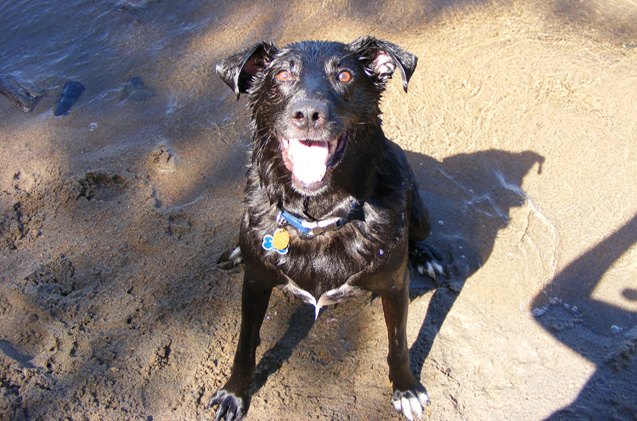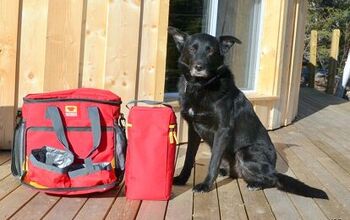10 Essential Tips For Camping With Your Dog

Camping is a budget-friendly activity that lets you get back to nature. And you know who really loves nature? Your dog! Camping aficionado Vanessa Chiasson, the blogging brains behind Turnipseed Travel (a site that’s passionate about great value and getting the absolute most for your hard earned dollars and days off), gets down and dirty with 10 essential tips you’ll need to know before camping with your dog.
Camping is a classic way to enjoy a fun, affordable vacation with friends and family. It doesn’t matter whether your style ranges from extended expeditions through challenging terrain or a simple weekend getaway of car camping in a nearby state park – chances are, there’s a campground for you! Even the more remote locations are offering great amenities these days. From refurbished shower stations and picnic areas to camp stores, ice cream counters, and free wi-fi, camping is more accessible and welcoming than ever before. And if you think you’ll love camping, it’s nothing compared to how much your dog will!
Camping and dogs are a natural fit. So many nooks and crannies to explore, so many squirrels to put in line, so much delicious mud and dirt! Chances are, your dog will LOVE a camping trip and will be begging for more!
And now, more than ever, we’re looking for ways to travel AT ALL, and camping is it for many of us.
Things To Think About Before Camping With Your Dog
While many think that camping is just setting up a tent and hanging with your dog and nature, that’s not necessarily the case. Particularly now where even outdoor parks and campgrounds have restrictions on who can be there, how many can be there, and what you can do.
When you’re planning to go camping with your dog, you’ll want to be sure to do your research. Some places that maybe allowed dogs before simply may not now. Many national parks and wildlife refuges won’t allow dogs on hiking trails. This means that maybe they ARE allowed to be on the campground with you, you’ll have to have a plan for them should you decide to hit the trails wherever you’re staying. (We know it goes without saying but leaving them at the campground is never an option.) You may not even want to tackle those places for camping if your dog being with you will mean that you’ll not be able to do much of anything and you’ll want to know this BEFORE YOU GET THERE. Imagine getting to your destination and finding out that your dog is basically allowed to be at your tent or your vehicle? Not good. Not good at all.
You also need to look at what will be good for you and your dog. Sure, you might want to go to some amazing overlook, but how will your dog feel about it? Choose places that your dog will also enjoy–massive mountain hikes are probably not super-realistic. One thing you can do is call the visitor’s center of the places you’re planning to camp and simply ask how dog-friendly they really are. They don’t want you and your dog there but miserable any more than you want to be, so they’re going to tell you the truth.
Also, ask about how many dogs are allowed. You may be able to bring one dog, but if you have a pack? Good luck choosing who gets to go and who doesn’t. If you plan to backpack your pet, consider not just his comfort level with that but YOUR comfort level (and ability) as well.
If your dog will be walking, remember that even if dogs are allowed to travel with you, most places will not allow dogs to be off-leash, for the safety of the wildlife around as well as other hikers. Don’t be that person who says, “Oh but Fido is great with wildlife and people.” Sure he is. Until a random rabbit takes off and then? Even the best-trained dogs may just not be able to resist the temptation.
The good news, though, is that with some research and a really honest assessment of your and your dog’s ability levels and preferences, camping with your dog can be an amazing experience. He may come to love seeing you pack up the tent because camping does lend itself to lots of together time, and what pup doesn’t love that with his hoomans?
Here are ten tips to make the experience a safe, smooth, and successful one.
1.) Talk to your vet.
If you are spending time outdoors, they can recommend preventative tick medication, vaccines for Lyme disease, and even provide information on the safety of the lake water.
Make sure your dog is in good health if any long hikes are planned. This includes consideration for any physical limitations when it comes to physical activity.
Does your dog struggle to breathe after too much physical activity? This is a common problem in dogs with shorter snouts like the bulldog, pug, or Boston terrier. Is your dog getting up in years? If so, he may be experiencing arthritis, making it more difficult to keep up on the trails. If your dog still wants to hike but feels a little pain after being active, your vet may also have recommendations for pain management without fully limiting your dog’s active lifestyle.
Related: Rustic Tips To Remember When Camping With Dogs
2.) Prepare your papers.
Crossing a national border will require vaccine papers, as do some state parks (for proof of rabies protection). If your dog decides he hates camping and wants to check into a Pet Hotel, they will also require vaccination records.
Medication should be accompanied by prescriptions and it’s always a good idea to research local veterinarian services or emergency veterinary clinics just in case.
Another important reason to keep paperwork on hand is to provide you with the information needed in case of an emergency. This includes a medical history for any necessary veterinary care (especially if your dog has specific medical needs) as well as details to help you find your dog if he is lost. Make sure to include a picture of your dog with your documentation for Lost Dog posters.
3.) Enjoy the ride.
Make sure you stop on route so Fido can stretch his legs – he might be a bit cramped with all the camping gear packed in! Keep a bottle of water and a collapsible bowl with you at all times and offer frequent drinks.
If your dog isn’t comfortable in the car, there are some steps that you can take to relax him and help make the trip easier. Bring along his favorite blanket or toys for the ride. Having something familiar nearby can really help with any nerves and anxiety. You may also be interested in using calming treats or supplements.
4.) Pick your site with care.
Depending on your dog’s temperament, it might be wise to choose a more secluded patch of land to pitch your tent. A campsite next to the washroom or water tap means increased foot traffic near your site, which not all dogs will appreciate.
Watch out for trails nearby. While it might not look obvious that there is something close at first glance, having the foot traffic of the hikers coming through can be upsetting for some dogs. Especially if they hear people nearby and can’t spot them.
You can also take your dog’s interests into consideration when selecting a site. If you have a dog that loves swimming, you may want to search out a waterfront site that will allow your dog to take a dip when the temperatures rise. On the other hand, a more laid-back dog may prefer a site with a large tree creating a comfortable, shaded spot to nap.
Related: Hot Dogs And Campfire Safety
5.) Call in the rangers!
Park rangers are a wealth of information and they can help with everything from recommending the best site for privacy, which nature trails are pet friendly, and even what sections of the beach welcome dogs.
They are also very familiar with the area around them. This means that they could help you find the nearest pet store if you run out of dog food or an emergency vet if you’re not sure where one might be in the event of an emergency.
6.) Priority setup.
Before you pitch the tent (or crack open the first beer!), take care of your dog. We first walk the perimeter of the site with our dog Chester so he has a chance to check everything out. We have a special 12-foot cable that we use in lieu of a leash. We set up his food and water dishes, taking care to bring his bowls from home.
We also set up a sun shelter if our site lacks natural shade. Shy pets will greatly appreciate the creation of a “fort” or “den” where they can get away from it all. A large sheet draped over a picnic table does the trick.
If you aren’t interested in using a leash or tie-out at your campsite, consider setting up a containment system like an exercise pen. This will keep your dog safely contained to your site where you can keep an eye on him, preventing him from running off and getting into trouble, while still providing some sense of freedom to move around the site.
7.) Nap time.
If setting up camp tires you out, imagine what it does to your dog! We try to have nap time every day. One of us will read in the tent while Chester naps – it’s a great time for both of us to refuel. Pets should never be left alone in a tent. Just like a car, the temperature inside a sealed-up tent can soar and a panicked pet could hurt themselves trying to fight their way out.
8.) Long live the leash!
It’s so tempting to just let your dog run free at a campground but always obey the leash rules. There are many reasons why leash rules have been put in place, all designed to keep everyone using the space both safe and healthy.
If you’re not convinced to do so out of consideration of other campers or for your pet’s safety, maybe the thought of sharing a tent with a skunk-sprayed pooch will do the trick!
Your dog may be dog-friendly, but that isn’t true for every dog. While you are out and about at the campground, you may encounter dogs that are nervous or reactive. Your dog’s intentions when coming up to say “hello” don’t matter, they are just put off by a strange dog approaching them and it can create a dangerous situation. At the same time, not every person is comfortable around dogs, especially strange dogs!
9.) Bugs and sun.
We use a child-friendly mosquito spray on Chester and also apply gentle sunscreen to his nose area.
10.) Bath time!
Congratulations! Your dog now smells worse than ever before! We always time our campground departure to coincide with a professional grooming once we get home.
We’ve camped with Chester on the coast of the Atlantic Ocean in northern Prince Edward Island, in the middle of the fall colors in Northern Vermont, and along the sand dune-swept beaches of Lake Ontario. No matter what the season, the location, or the duration we always have a wonderful time, and having Chester with us only enhances the fun. I hope you can employ these tips to make your next pet-friendly camping trip one of your best vacations ever!

More by Lori Ennis
























